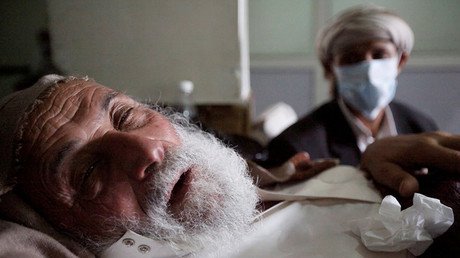Meet Hameed: 12yo Yemeni boy is battling cholera after having 23 surgeries & losing arm (GRAPHIC)
A 12-year-old Yemeni boy has undergone 23 surgical operations, including the amputation of his left arm, after falling victim to the war in his country that left him with terrible scars. He is now battling cholera.
READ MORE: Yemen cholera epidemic kills 2,000, infects 500,000 as outbreak hits ‘grim milestone’
Hameed has had a rough childhood. In 2014, the boy was electrocuted when a high-voltage cable fell from a transmission tower during armed clashes in Yemen’s Amran governorate. The shock was enormous, but the kid survived.
For the past several years, he has been in and out of the hospital with various health-related problems.
“Even a slight cough affects him badly. He’s very weak. His elbow has been damaged by frequent falls,” Hameed’s father, Faraj Al-Asadi, told RT.
“As you can see, his neck is injured as well. These tragedies come from war. The boy spent a month in intensive care before regaining consciousness. He’s undergone surgery many times and will need more operations. Look at all his injuries.”
Hameed, his face and body awash with heart-stopping scars, is also battling with repeated cholera infections.
More than half a million people in Yemen have been infected with cholera since the outbreak began in spring, the World Health Organization (WHO) said last week.
"The total number of suspected cholera cases in Yemen this year hit the half a million mark, and nearly 2,000 people have died since the outbreak began to spread rapidly at the end of April," the WHO said in a statement.
Yemen's cholera epidemic is currently the “largest in the world,” the WHO says. The disease has been spreading like wildfire due to worsening hygiene and sanitation conditions and disruptions to the water supply across the country. Local residents are cut off from clean water.
“Half of the people who are affected by the cholera are children, and a quarter of the people who have died from suspected cholera cases are children," Marie Claire Feghali, regional communications manager with Red Cross, told RT.
A few key reasons contributed to the deadly disease outbreak in Yemen.
READ MORE: Yemen’s national blood bank on verge of closing after losing Western funding
“Everything in the country has collapsed. That includes the water system, the health system, it also includes the fact that there’s no garbage collection in the country. Cholera is a water-borne disease. When you don’t have garbage collection, when you don’t have proper treatment of the water, it’s a whole number of factors that cause this cholera outbreak to be as serious as it is and as it was.”
“The situation in Yemen in general is extremely bad. It’s a man-made situation. It’s due to the fact that there’s a war going on in the country and there are people, who are civilians, who are paying the highest price,” Feghali said.
Yemen's ongoing conflict and a “man-made” humanitarian catastrophe has “no end in sight,” the head of the UN Development Program (UNDP) in the war-torn country said in August, warning that nearly 7 million people are at risk of starvation.
Around 70 percent of Yemenis are in urgent need of humanitarian aid. Roughly 60 percent have no prospects of securing their next meal as nearly 7 million “are close to slipping into a state of famine,” Auke Lootsma, UN Development Programme (UNDP) Country Director said earlier this month.
The Saudi-led coalition launched its aerial bombing campaign in support of the ousted Yemeni president, Abd-Rabbu Mansour Hadi, in March 2015. The campaign targets the remnants of the country’s military loyal to former President Ali Abdullah Saleh and the Houthi rebels. The casualties in the fighting have surpassed 10,000 dead and 40,000 injured by January 2017, according to the UN estimates, with civilians making up a large share of victims. The bombing failed to bring victory to the Saudi-backed side in the conflict, but devastated Yemeni cities and infrastructure.
"Since March 2015, OHCHR has documented 13,609 civilian casualties, including 5,021 killed and 8,588 injured. These numbers are based on the casualties individually verified by the UN human rights office in Yemen," UN High Commissioner for Human Rights (OHCHR) spokesman Rupert Colville said in July.
Colville, however, noted at the time that the “overall number” of civilians killed could be much higher and estimated it to be over 11,000.
Some two-third of the verified civilian deaths were caused by Saudi-led coalition airstrikes, while the rest of the victims were killed by Houthi rebels and terrorist groups Islamic State (IS, ISIS/ISIL) and Al-Qaeda, Colville told Anadolu Agency.
Leading humanitarian organizations have named the aerial bombing the main cause of civilian deaths in the country.
The Saudi-led coalition has struck civilian targets on numerous occasions, but acknowledged only few of the attacks, calling them “mistakes” caused by “bad intelligence.”
READ MORE: Yemen hit by more airstrikes in 1st half of 2017 than in whole of 2016 – aid agencies
The military campaign is supported by a tight air and naval blockade on Yemen, backed by the US. The situation has effectively led to healthcare collapse, according to Under-Secretary-General for Humanitarian Affairs and Emergency Relief Coordinator Stephen O'Brien.
A UN report, leaked last week, indicates that Riyadh-led coalition strikes have resulted in hundreds of Yemeni children being killed or maimed. The confidential draft was to be presented by the UN Secretary-General, but was it first seen and published by Reuters and Foreign Policy (FP) magazine. The report alleges, that Saudi forces and their Gulf allies were complicit in over half of the deaths and injuries of children in Yemen last year.
“The killing and maiming of children remained the most prevalent violation” of children’s rights in Yemen, the 41-page paper says, as cited by FP. “In the reporting period, attacks carried out by air were the cause of over half of all child casualties, with at least 349 children killed and 333 children injured,” the report added, urging that Riyadh and its allies be added to a black list of countries violating children's rights.
















